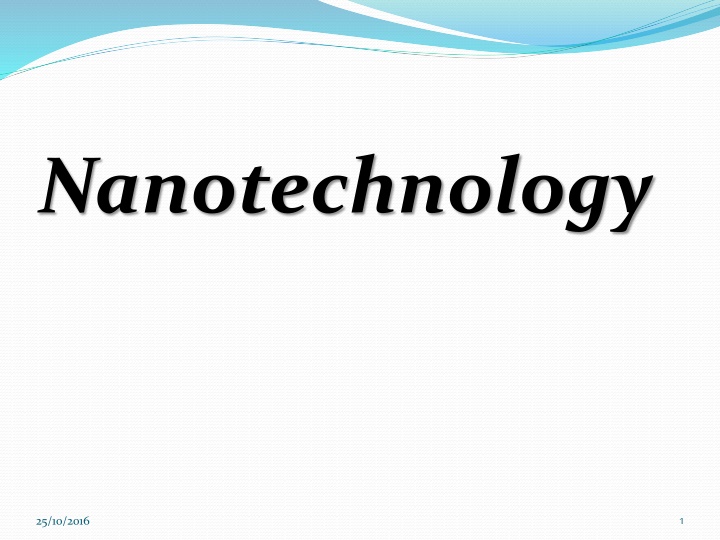
Exploring Nanotechnology: Materials, Structures, and Applications
Discover the world of nanotechnology with a focus on nanomaterials, dimensional systems, and classifications. Explore various types of nanostructures and nanomaterials like carbon-based materials, metal-based materials, dendrimers, and composites. Dive into the intriguing world of nanotechnology and its diverse applications.
Download Presentation

Please find below an Image/Link to download the presentation.
The content on the website is provided AS IS for your information and personal use only. It may not be sold, licensed, or shared on other websites without obtaining consent from the author. If you encounter any issues during the download, it is possible that the publisher has removed the file from their server.
You are allowed to download the files provided on this website for personal or commercial use, subject to the condition that they are used lawfully. All files are the property of their respective owners.
The content on the website is provided AS IS for your information and personal use only. It may not be sold, licensed, or shared on other websites without obtaining consent from the author.
E N D
Presentation Transcript
Nanotechnology 1 25/10/2016
2-dimensional systems: with two dimensions over the nanometric range, these materials are constituted by large lamellae of nanometric thickness, often separated by pillars to avoid collapsing of the structure. Main applications of these materials are intercalation with other materials, Typical materials belonging to this groupare nanostructured clays. 3-dimensional systems: the materials of this group are constituted by complex structures of channels and/or cages interconnected to create a three-dimensional structure. They are mainly used as storage systems or as scaffolds to obtain porous materials in metal or carbon. Examples of this group are numerous three-dimensional structures in silicon or metal oxide. 2 25/10/2016
Classification of nanomaterials Depending on the dimension in which the size effect on the resultant property becomes apparent, the nanomaterials can be classified as zerodimensional (quantum dots) in which the movement of electrons is confined in all three dimensions, one-dimensional which the electrons can only move freely in the X- direction, two-dimensional (thin films) in which case the free electron can move in the X-Y plane, or three dimensional (nanostructured nanoparticles as building blocks) in which the free electroncan move in theX, Yand Z directions. (quantum wires) in material built of 3 25/10/2016
Figure (2) Density of states for 3D, 2D, 1D, 0D . 4 25/10/2016
DifferentTypesof Nanostructures (NSs) All bulk materials can be transformed at nanoscale including polymers; metals, glass, semiconductors and ceramic etc. There are different classifications of NSs in nanotechnology, NSs usually classified geometrical properties. nanocages, nanocrystallites, nanobelts, nanoneedles, nanocomposites, nanofabrics, nanoflakes, nanoflowers, nanofoams, nanomeshes, nanoparticles, nanopillars, nanoshells, nanopowders, nanoclusters, nanowires, nanotubes, quantum dots. by their consist NSs usually of nanofibers, nanorings, nanorods, 5 25/10/2016
Typesof Nanomaterials (NMs) For understanding, nanomaterials are designed into fourtypesas follows: (i) Carbon based materials (ii) Metal based materials (iii) Dendrimers (iv) Composites (i) Carbon based materials: These are composed of carbon, taking the form of hollow spheres, ellipsoids or tubes. The spherical and ellipsoidal forms are referred as fullerenes, while cylindrical forms are called nanotubes. 6 25/10/2016
Figure (3)Carbon nanostructures 7 25/10/2016
Graphene Graphene is a crystalline allotrope of carbon with two- dimensional, atomic scale, hexagonal pattren. It is the basic structural element of other allotropes like graphite, fullerene, nanotubes, nanocones, etc. hence called mother of all carbon nanomaterials (Figure 4). Nowdays, it is commonly used in semiconductors, batteries, electronics, composite industries, and many more. 8 25/10/2016
Figure (4) Grapheneand other carbon nanomaterials 9 25/10/2016
(i) Metal based materials: These include quantum dots, nanogold, nanosilver and metal oxides like TiO2. A quantum dot is a closely packed semiconductor crystal comprised of hundreds or thousands of atoms, whose size is on the order of a few nanometers to a few hundred nanometers. (ii) Dendrimers: Dendrimers are repetitively branched molecules. The name comes from the Greek nanomaterials are nanosized polymers built from branched units. The surface of dendrimer has numerous chain ends, which can perform specific chemical functions. Dendrimers are used in molecular recognition, nanosensing, light harvesting, and opto- electrochemical devices. They may beuseful fordrugdelivery. word dendron (tree). These (iii) Composites: Composites are combination of nanoparticles with other nanoparticles or with Nanoparticles like nanosized clays are added to products (auto parts), packaging materials, etc.) to enhance mechanical, thermal, and larger., bulk- type materials. 25/10/2016 flame retardantproperties. 10
Figure (5) Some types of nanomaterials 11 25/10/2016
Optical properties in Nanomaterials:- Nanocrystalline systems have attracted much interest due to their novel optical properties, which differ remarkably from bulk crystals. Applications based on optical properties of nanomaterials include optical detector, sensor, imaging, display, solar cell, photocatalysis, photoelectrochemistry and biomedicine. 12 25/10/2016
Interaction of light with matter : The colour of a material is a function of the interaction between the light and the object. If a material absorbs light of certain wavelengths, an observer will not see these colours in the reflected light. Only reflected wavelengths reach our eyes and this makes an object appear a certain colour. For example, leaves appear green because chlorophyll, which is a pigment, absorbs the blue and red colours of the spectrum and reflects the green. In general light (I) incident on a material can be transmitted (T), absorbed (A) or reflected (R): I = T+A+R As the size of the materials is reduced, scattering (S) of light can also contribute to its colour (or transparency). 13 25/10/2016






















